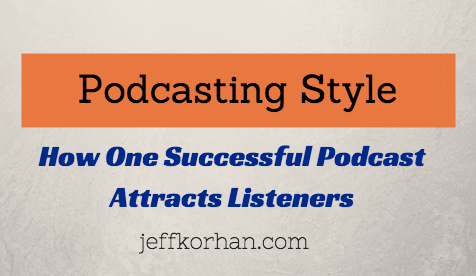Podcast: Play in new window | Download
Subscribe: RSS

This is Episode 39 of This Old New Business weekly business podcast with Jeff Korhan.
Joel Boggess is the co-host with Dr Pei of ReLaunch, a Podcast show that has earned several awards and grown by over a factor of 10 in just it’s first year.
Joel’s earlier career as a traditional broadcaster made for a natural transition to podcasting. In this episode he shares why every podcaster has to develop his or her own unique style, how to go about doing that, and much more, including the vital importance of promoting your podcast.
Our Featured Guest: Joel Boggess
 Joel Boggess is the host of the award-winning ReLaunch podcast show, and the author of the #1 Amazon bestselling book – Finding your Voice. Joel is passionate about sharing fresh ideas, success tips and inspiration through real life stories, and has a personal goal to help millions.
Joel Boggess is the host of the award-winning ReLaunch podcast show, and the author of the #1 Amazon bestselling book – Finding your Voice. Joel is passionate about sharing fresh ideas, success tips and inspiration through real life stories, and has a personal goal to help millions.
Help People Tell Their Story
Storytelling is the backbone of marketing, and podcasting is indeed a form of content marketing that becoming increasingly relevant.
Stories are relatable because they help us make sense of the world. Everyone wants to tell their story, provided they have a safe place for doing so.
This is a skill that Joel has developed over decades in the business of broadcasting. Having been a guest on ReLaunch, I know with certainty that Joel’s podcasting style not only puts his guests at ease, it creates a more natural dialogue that brings out fresh ideas.
Joel notes that 75-80% of his audience are listening with a mobile device. When you consider Google recently adjusted its search rankings to favor mobile friendly content, it stands to reason that podcasting is an ideal platform for marketing your business with style.
I’d love to hear your thoughts on podcasting style? Meet me over on Twitter to take the conversation further.
Lighting Round Tips and Advice
Joel’s Top Sales or Marketing Advice – Know your ideal customer. Create an ideal customer and name it to make it real.
His Favorite Productivity Tip – Have your goals set before you get there, such as before the week starts.
A Quote that has Inspired Joel’s Success – “I will not be out-worked.” Will Smith
Key Take-Aways
- Learn more about Joel at ReLaunchShow.com, and his new training course: How to Launch Your No. 1. Podcast
- Check out Joel’s book: Finding Your Voice: Sort Through the Clutter and Discover Clarity, Confidence, Direction
- Listen to the audio to learn how to market to your ideal audience. Our newsletter subscribers learned more about this technique last week. Check it out here.
How to subscribe to This Old New Business podcast
Click here to subscribe via iTunes.
You can also subscribe via Stitcher.
Help us Spread the Word
If you enjoyed this episode of This Old New Marketing podcast, please head over to iTunes or Stitcher to leave a rating, write a review, or subscribe.
About the Author: Jeff Korhan, MBA, is the author of Built-In Social: Essential Social Marketing Practices for Every Small Business and host of This Old New Business podcast.
He helps mainstream businesses adapt their traditional growth practices to a digital world. Connect with Jeff on LinkedIn, Twitter, Facebook, and Google+



